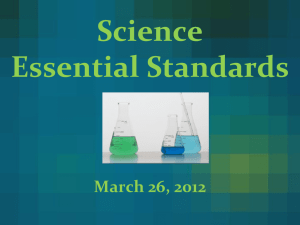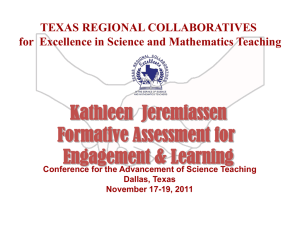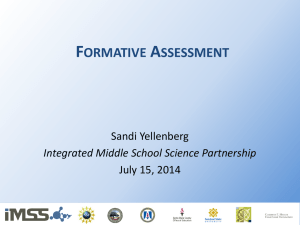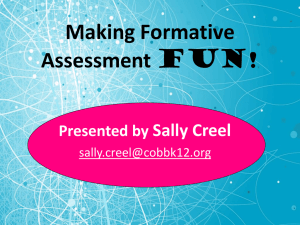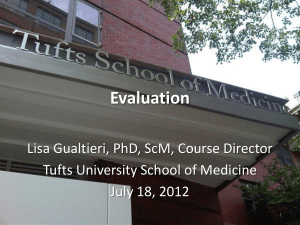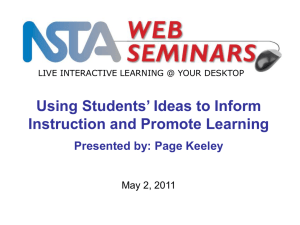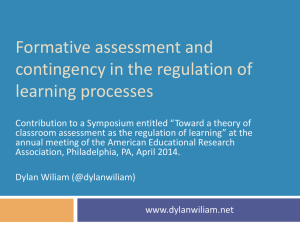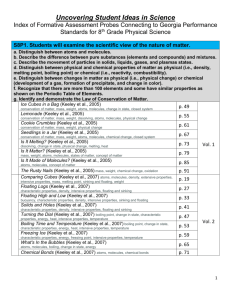Formative Assessment Probes
advertisement
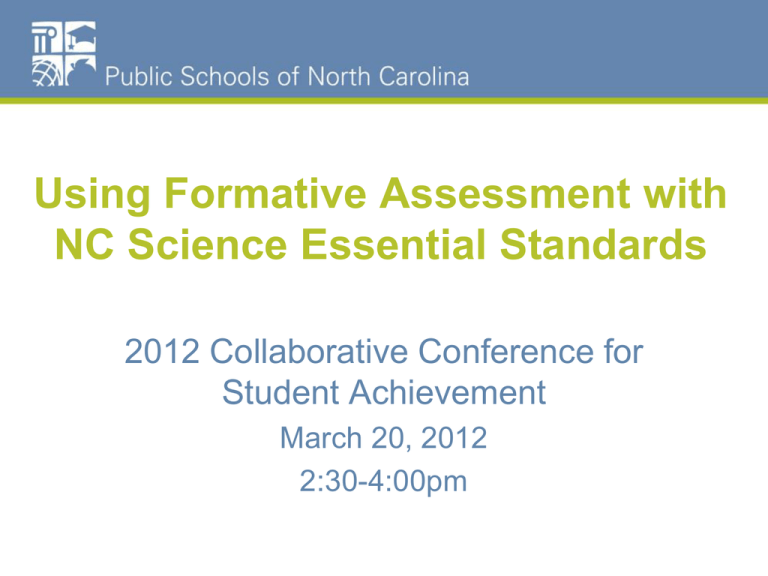
Using Formative Assessment with NC Science Essential Standards 2012 Collaborative Conference for Student Achievement March 20, 2012 2:30-4:00pm Expected Outcomes • To learn about assessment probes as a tool for formative assessment • To identify types of assessment probes • To link concepts in the NC Science Essential Standards and research on learning to specific assessment probes • To incorporate probes into Formative Assessment Plans Formative Assessment Probes A probe… – Is a purposefully designed question that reveals more than just an answer. – Elicits a response that helps teachers identify students’ ideas about a concept or phenomena. – Promotes thinking and discussion of ideas. Definition from Mundry, S., Keeley, P., and Landel, Carolyn (2010). A leader’s guide to science curriculum topic study. Arlington, VA: NSTA Press. From Keeley, P., Eberle, F. and Farrin, L. (2005). Uncovering student ideas in science(Vol.1)-25 formative assessment probes. Arlington, VA: NSTA Press. NC Science Essential Standards Vertical Progression PSc.3.2.4 Illustrate the Phy.2.2.2 Analyze wave wave interactions of reflection, refraction, diffraction, and interference. behaviors in terms of transmission, reflection, refraction and interference. 6.P.1.2 Explain the relationship among visible light, the electromagnetic spectrum, and sight. 6.P.3.2 Explain the effects of electromagnetic waves on various materials to include absorption, scattering, and change in temperature. 4.P.3.2 Recognize that light travels in a straight line until it strikes an object or travels from one medium to another, and that light can be reflected, refracted, and absorbed. Example Topic: Interaction of Light & Matter Related Ideas in National Science Education Standards (NRC 1996) – K-4 Properties of Objects and Materials Objects have many observable properties. – K-4 Light, Heat, Electricity, and Magnetism Light can be reflected by a mirror, refracted by a lens, or absorbed by an object. – 5-8 Transfer of Energy Light interacts with matter by transmission (including refraction), absorption, or scattering (including reflection). For a person to see an object, light from that object –emitted by or scattered from it –must enter the eye. Example Topic: Interaction of Light & Matter Related Ideas in Benchmarks for Science Literacy (AAAS 1993) • K-2 Structure of Matter Objects can be described in terms of their physical properties (color, texture, etc.) • 3-5 Motion (New benchmark, AAAS 2001) Light travels and tends to maintain its direction of motion until it interacts with an object or material. Light can be absorbed, redirected, bounced back, or allowed to pass through. Example Topic: Interaction of Light & Matter Related Ideas in Benchmarks for Science Literacy (AAAS 1993) (continued) •6-8 Motion – Light from the Sun is made up of a mixture of many different colors of light, even through to the eye the light looks almost white. Other things that give off or reflect light have a different mix of colors. – Something can be “seen” when light waves emitted or reflected by it enter the eye. •9-12 Motion – Waves can superpose on one another, bend around corners, reflect off surfaces, be absorbed by materials they enter and change direction when entering a new material. Research on Student Learning • Middle school students often will accept the idea that mirrors reflect light but may not accept the idea that ordinary objects reflect light. • Some students even lacked a conception of light bouncing or reflecting off any objects. They thought color to be a property of an object rather than related to interaction with light. From Keeley, P., Eberle, F. and Farrin, L. (2005). Uncovering student ideas in science(Vol.1)-25 formative assessment probes. Arlington, VA: NSTA Press. Suggestions for Instruction & Assessment • Explicitly link the idea of “seeing” to reflected light. • Concrete experiences comparing rough and smooth surface reflection • Connect to real-life applications, such as remote sensing images by satellites. • Ask students to draw and explain ray diagrams. • Explain what happens when light interacts with materials associated with these properties: texture, luster, color, transparent, translucent, opaque. • Distinguish between the general references for reflection in the English language and scientific meaning. • Have students generate their own list. From Keeley, P. and Harrington, R.(2010). Uncovering student ideas in physical science-45 new force and motion assessment probes. Arlington, VA: NSTA Press. From Keeley, P., Eberle, F. and Farrin, L. (2005). Uncovering student ideas in science(Vol.1)-25 formative assessment probes. Arlington, VA: NSTA Press. From Keeley, P.(2011). Uncovering student ideas in life science-25 new formative assessment probes. Arlington, VA: NSTA Press. From Keeley, P., Eberle, F. and Dorsey, C. (2008). Uncovering student ideas in science(Vol.3)-another 25 formative assessment probes. Arlington, VA: NSTA Press. Oil is an important energy resource used by humans. Several friends were arguing about where this energy resource came from. This is what they said: Julie: “It came mostly from fossil remains of giant ferns and trees that lived millions of years ago.” Ross: “It came mostly from inside ancient rocks that melted inside the Earth millions of years ago.” Delores: “It came mostly from a gooey liquid that was inside ancient volcanoes millions of years ago.” Nathan: “It came mostly from the remains of dinosaurs that decayed millions of years ago.” Edie: “It came mostly from a gooey liquid that was inside ancient volcanoes millions of years ago.” Seth: “It came mostly from microscopic and other ocean organisms millions of years ago.” Justine: “It came mostly from ancient mud, sand, and soil that eventually turned to liquid inside the Earth millions of years ago.” Malia: “It came mostly from gasoline that was trapped inside the Earth’s crust for millions of years.” Cecelia: “It came mostly from the rotting blubber of ancient whales that lived millions of years ago.” Circle the name of the person you most agree with. Explain your thinking. Describe where you think oil came from and how it was formed. From Keeley, P. and Tugel, J. (2009). Uncovering student ideas in science(Vol.4)- 25 new formative assessment probes. Arlington, VA: NSTA Press. Types of Probes • • • • Justified List Prediction Familiar Phenomena Friendly Talk Formative Assessment Model NC FALCON North Carolina’s Formative Assessment Learning Community’s Online Network Resources • NC Education Online Training https://center.ncsu.edu/nc/ • NSTA Science Curriculum Topic Study and Leader’s Guide by Page Keeley http://www.curriculumtopicstudy.org/ • NSTA Store http://www.nsta.org/store/ • – Uncovering Student Ideas in Science Formative Assessment Probes (Volumes 1-4) – Uncovering Student Ideas in Physical Science – Uncovering Student Ideas in Life Science – Science Formative Assessment: 75 Practical Strategies for Linking Assessment, Instruction, and Learning NC Science Wiki http://scnces.ncdpi.wikispaces.net/home – K-12 Science Essential Standards by Strand (Excel file) – Customized Curriculum Topic Study (CTS) Guides for Essential Standards K-12 Strands – Recorded Webinar Series focusing on using NC CTS Strand Guides Would you be interested in applying to write Formative Assessment Plans aligned with NC Science Essential Standards for NCFALCON? • • • • • Google Docs Application Form We need your expertise! Tentatively scheduled for June 2012 Pre-approval by your district will be required. Teachers will receive a stipend. In North Carolina Jami Inman Secondary Science Consultant Jami.inman@dpi.nc.gov 919-807-3607 NCSTA
